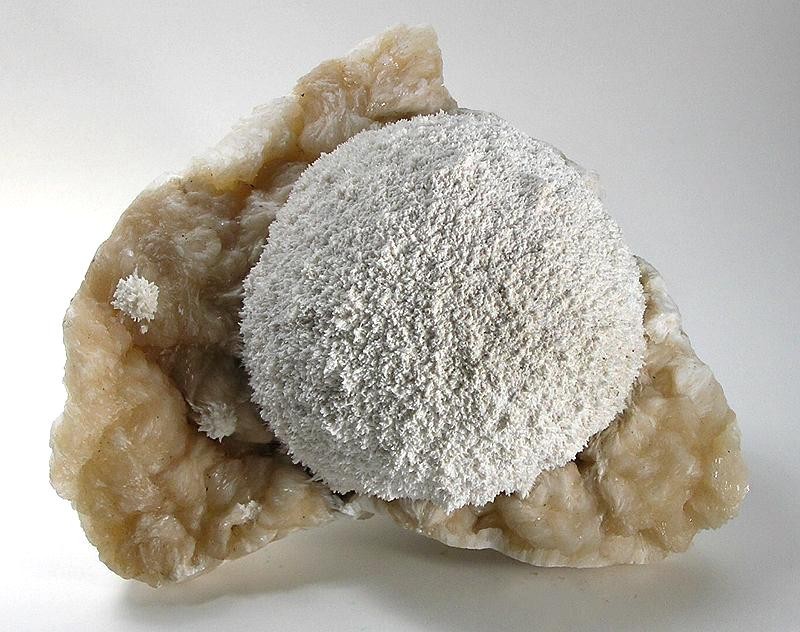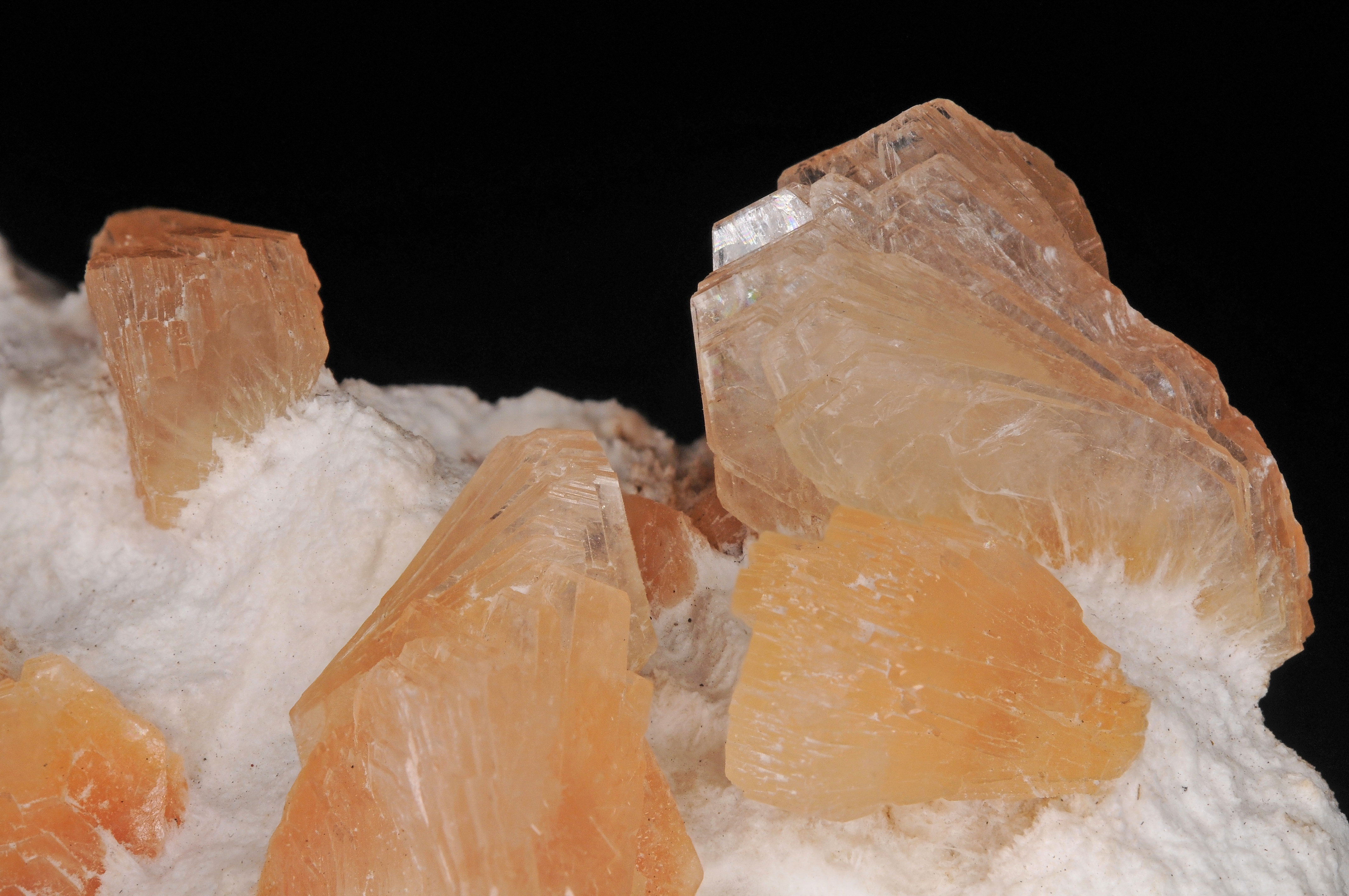
モルデナイト宝石:特性、意味、価値など
 モルデナイトは、豊富なゼオライト鉱物で、宝石として用いられることもありますが、商業的に利用されることの方が多いです。一般的には白色または無色のこの石は、繊維状の構造を持つことが多く、「キャッツアイ」効果を引き起こすことがあります。
モルデナイトは、豊富なゼオライト鉱物で、宝石として用いられることもありますが、商業的に利用されることの方が多いです。一般的には白色または無色のこの石は、繊維状の構造を持つことが多く、「キャッツアイ」効果を引き起こすことがあります。
希少性という点では、鉱物自体は最も一般的なゼオライトの 1 つですが、宝石としては非常に珍しいものです。
モルデナイトは天然ゼオライトですか? はい、モルデナイトは天然ゼオライトです。ただし、モルデナイトの工業用途では合成モルデナイトが好まれることが多いです。
このガイドでは、モルデナイトの用途、特性、歴史、価格などについて詳しく説明します。
 上の写真:モルデン石晶石 | 画像提供:Rob Lavinsky、 iRocks.com – CC-BY-SA-3.0
上の写真:モルデン石晶石 | 画像提供:Rob Lavinsky、 iRocks.com – CC-BY-SA-3.0
モルデナイト石について
モルデナイトは、天然では白色または無色ですが、他の色に染まることもある珍しい半貴石です。この石の以前の愛称には、以下のようなものがあります。
アルドゥイナイト
アシュトナイト
スティライト
プチロライト
擬似ナトロライト
「擬似ナトロライト」というのは少し誤解を招く名称ですが、モルデナイトとナトロライトはどちらも商業的に重要なゼオライトです。
ところで、モルデナイトは何に使われるのでしょうか?
モルデナイトの用途
多くのゼオライトと同様に、モルデナイトは工業用途および商業用途で広く知られています。工業的に使用されるモルデナイトのほとんどは合成物であり、天然物よりも純度が高いためです。
モルデナイトの貴重な特性としては、強い酸性度、熱的および化学的に高い安定性、大きな細孔サイズなどが挙げられます。
モルデナイトは次のような用途でよく使用されます。
触媒:化学反応の速度を上げる。通常は石油化学産業で使用される。
吸着剤:化学物質や油の流出などの物質を表面に引き寄せます
分子ふるい:細孔の大きさによって分子を分離します。石油産業ではクラッキング(分子鎖の分解)、化学実験室では溶媒の乾燥、給気ろ過に使用されます。
乾燥剤:エタノール燃料、医薬品容器、食品添加物(固結防止剤)、電子部品包装、生鮮化学品包装用の乾燥剤
ディメンションストーン:農業や建設業界で使用される装飾用または構造用の石材
科学者たちは鉱物学的研究のためにモルデナイトを合成したこともあります。
 上の写真:モルデン石の球状結晶(束沸石結晶の上)|画像提供:Rob Lavinsky、 iRocks.com – CC-BY-SA-3.0
上の写真:モルデン石の球状結晶(束沸石結晶の上)|画像提供:Rob Lavinsky、 iRocks.com – CC-BY-SA-3.0
モルデナイトの仕様と特性
まず、モルデナイトは何からできているのでしょうか?モルデナイトは、ナトリウム、カリウム、カルシウムを含む含水アルミノケイ酸塩です。鉱物の化学式は(Ca,Na₂,K₂)Al₂Si₁₀O₂₄·7H₂Oまたは(Na₂,Ca,K₂)₁₀(Al₁₀Si₁₀)O₂₄·2₁₀Oと表記されます。後者は国際鉱物学協会(IMA)によって承認されています。マグネシウムは一般的な不純物です。
モルデナイトは、シリコンとアルミニウムの比率が高いため、酸による攻撃を受けにくく、工業的に価値が高くなります。
モルデナイトはゼオライトの一種です。他によく知られているゼオライトとしては、トムソナイト、ナトロライト、チャバザイト、スティルバイトなどがあります。
結晶は柱状で縦縞が入ったものもあれば、細長く針状のものもあります。また、密集した塊、放射状の結晶クラスター(通常は針状)、綿状、腎状、磁器状、繊維状の集合体として産出するものもあります。
分子レベルでは、モルデナイトの構造は、5 員環上にケイ酸塩とアルミネート四面体の鎖が連なったフレームワークです。
モルデナイトの特性一覧:
モース硬度:4~5
色:無色、白、淡黄色、淡ピンク
結晶構造:斜方晶系
光沢:ガラス質または絹のような光沢;{010}に真珠のような光沢
透明性:透明から半透明
屈折率:1.472-1.487
密度:2.12~2.15
劈開:{100}では完全、{010}では明瞭/良好
骨折:貝殻状または不規則/凹凸
縞模様:白
発光:なし
多色性:なし
複屈折:0.005
分散:なし
光学現象:シャトヤンシー
鉱物学から離れて、モルデナイトの精神的な意味は何でしょうか?
 上の写真:灰色の石英の空洞に置かれた白いモルデナイトの球体|画像提供:Rob Lavinsky、 iRocks.com – CC-BY-SA-3.0
上の写真:灰色の石英の空洞に置かれた白いモルデナイトの球体|画像提供:Rob Lavinsky、 iRocks.com – CC-BY-SA-3.0
モルデナイトの意味と歴史
モルデナイトの結晶は豊かさ、再生、平和、そして透明感を象徴しています。
多くのオカルト実践者は、白魔術の儀式にモルデナイトを使用します。白魔術は「保護魔術」または「高位魔術」と呼ばれることもあり、他者や物を助け、利益をもたらし、癒すという善意によって特徴づけられます。
歴史
モルデナイトの最も古い証拠は、モルデナイト、クリストバライト、そして石英を含むチャートビーズです。2000年頃にアンティグア島で発見されたこのビーズは、西暦250年から500年頃のもので、当時は宝飾品の製造拠点であったと考えられています。
モルデナイトの名称は、最初に発見された場所、カナダのノバスコシア州モーデンに由来しています。イギリス系カナダ人の化学者、地質学者、鉱物学者であるヘンリー・ハウがこの鉱物を発見し、モルデナイトと命名し、1864年に最初の文献を発表しました。
「プチロライト」との混同
1886年、アメリカの地質学者で岩石学者のチャールズ・ホイットマン・クロスとL・G・イーキンスは、コロラド州ジェファーソン郡で発見されたとされる新鉱物を報告しました。彼らは羽毛のような外観から、ギリシャ語で「羽」を意味する「ピュロン」にちなんで「プチロライト」と名付けました。
彼らはプチロライトについて、「アルミナ、石灰(酸化カルシウム)、アルカリ(酸化カリウムと酸化ナトリウム)からなる新しい含水ケイ酸塩」と説明しました。彼らはすぐにコロラド州カスター郡で別の鉱脈を発見しました。
1892年、クロスとイーキンスは、モルデナイトとプチロライトは同じ実験式を持つが、「物理的には非常に異なる」ことを指摘しました。
しかし、アメリカの化学者フランク・ウィグルスワース・クラークは、1892年にアメリカ科学誌の同じ号に「プチロライトとモルデナイトはどちらも同じ一般式で簡単に表すことができる」という論文を発表しました。
一部の出版物では依然としてこの鉱物を「プチロライト」と呼んでいましたが、1932 年にユタ州で Waldemar T. Schaller が「プチロライト」について報告したように、この名前はその後モルデナイトの同義語になりました。
最初の合成モルデナイト
1948 年、ニュージーランド生まれの化学者リチャード・メイリング・バラー (「ゼオライト化学の創始者」の異名を持つ) が、天然には存在しない初の合成ゼオライトと初の合成モルデナイトを開発しました。
 上の写真:モルデナイト標本上のヒューランダイト結晶|画像提供:Parent Géry、 CC-BY-SA-3.0
上の写真:モルデナイト標本上のヒューランダイト結晶|画像提供:Parent Géry、 CC-BY-SA-3.0
モルデナイトの治癒特性
モルデナイトは主に白色または無色のヒーリングストーンで、他の白色宝石と同様に、豊かさ、平和、浄化をもたらす力を持っています。モルデナイトは他のクリスタルと組み合わせることで、そのヒーリングパワーを高めることができます。
エネルギーヒーリングを実践する場合、モルデナイトは、最も高い、最も精神的なエネルギーの中心であるクラウンチャクラのバランスをとるための強力なチャクラストーンです。
多くのクリスタルヒーラーは、グリーンアポフィライトの標本にモルデナイトを添えて、 グリーンの宝石が持つ若返り、繁栄、喜びをもたらすエネルギーを取り入れています。また、モルデナイトにカバンサイトを添えるのも人気があり、ストレスの多い時期に安らぎをもたらすと言われています。
モルデナイトの身体的な利点は何ですか?
身体の治癒
身体的には、モルデナイトは肺、口、喉に関連する問題の緩和に効果があると言われています。
感情的な癒し
感情面では、モルデナイトは次のような効果があると信じられています。
静かで落ち着かない考え
うつ病を和らげる
集中力を高める
豊かさを引き寄せる
ネガティブな感情を払拭する
感情のバランスをとる
視点をより良い方向に変えましょう
モルデナイト宝石の特性
モルデナイトは非常に希少なため、標準的なグレーディング基準は存在しません。しかし、モルデナイトに適用される標準的な価値基準について、以下に説明します。
色: 無色または白色の標本が最も一般的ですが、淡いピンク色または黄色に染色されることもあります。
カット: ファセットカットされたモルデナイトも見つかるかもしれませんが、それらはモルデナイトと他の鉱物の混合である可能性が高いです。カットされた標本のほとんどはコレクター向けに作られています。 シャトヤンシー効果のあるモルデナイトは、この効果を発揮するためにカボションカットする必要があります。販売されているモルデナイトのほとんどは原石(カットされていないもの)です。
カラット重量とサイズ: 原石はかなり大きい場合もありますが、ほとんどのカボションは最大約 1 インチまでの結節から切り出されます。
原石といえば、モルデナイトはどのように形成されるのでしょうか?
 上の写真:モルデナイト上の桃色の輝石輝石と白い方解石の結晶|画像提供:Rob Lavinsky、 iRocks.com – CC-BY-SA-3.0
上の写真:モルデナイト上の桃色の輝石輝石と白い方解石の結晶|画像提供:Rob Lavinsky、 iRocks.com – CC-BY-SA-3.0
モルデナイトの形成と産地
モルデナイトは、堆積岩、溶岩流、または火砕堆積物の変質生成物として形成されるのが一般的です。火山性天然ガラスが水によって変質した場合にも形成されることがあります。
この石は主に、玄武岩、安山岩、流紋岩などの変質した火山堆積物や溶岩中に見られます。モルデナイトは海洋堆積物からも発見されています。
採掘場所
モルデナイトはどこで採掘されていますか? モルデナイト結晶の重要な産地には以下のようなものがあります。
ブルガリア
カナダ
デンマーク
イングランド
ハンガリー
アイスランド
イタリア
インド
日本
ニュージーランド
ノルウェー
ロシア
スコットランド
アメリカ合衆国(カリフォルニア州、コロラド州、アイダホ州、ニュージャージー州、オレゴン州、ユタ州、ワシントン州、ワイオミング州)
出典はさておき、モルデナイトの価格はいくらですか?
モルデナイトの価格と価値
前述の通り、モルデナイトは主に原石として販売されています。しかし、他の石と組み合わせたファセットカットの宝石も存在します。
これらのファセットカットされた宝石の価格は、1カラットあたり約25ドルから50ドルです。
モルデナイトの原石の多くは、アポフィライト、スティルバイト、カルセドニー、ヒューランダイトなどの鉱物と混合されています。低価格帯では、小さな標本が5ドルから25ドル程度で見つかります。
高額なのは、巨大でユニークな標本で、500ドルから12,000ドル、中には27,000ドルに達するものもあります。
カボションとカボションペンダントの価格は、一般的に 30 ドルから 35 ドル程度です。
 上の写真:アメジストのポケットに置かれた白いモルデナイトのボール|画像提供:Rob Lavinsky、 iRocks.com – CC-BY-SA-3.0
上の写真:アメジストのポケットに置かれた白いモルデナイトのボール|画像提供:Rob Lavinsky、 iRocks.com – CC-BY-SA-3.0
モルデナイトのケアとメンテナンス
まず、モルデナイトゼオライトは安全でしょうか?状況によります。繊維状のモルデナイトは、繊維を吸い込んだり摂取したりすると危険な場合があります。そのため、これらの粗い標本を扱う際(特に切断する場合)は、慎重に、予防措置を講じてください。
宝石の手入れに関しては、モルデナイトのジュエリーには保護セッティングを選択することをお勧めします。
モルデナイトは、ぬるま湯、中性洗剤、柔らかい歯ブラシで洗浄できます。傷がつかないように、他の宝石とは分けて保管してください。
モルデナイトをもっと欲しいですか?
宝石界ではあまり知られていないモルデナイトは、商業用途以外にも貴重な石です。気分を高揚させ、若返らせるエネルギーは、気分をリフレッシュさせ、ニュートラルな色合いはどんな空間にもマッチします。
Gemstone Encyclopedia検索
最新記事
ヤシ象牙彫刻は、植物象牙とも呼ばれ、南米のヤシ科植物フィテレファス属のヤシの実から倫理的に採取された、象牙の天然代替品です。このガイドでヤシ象牙についてすべて学びましょう!
15th Jan 2026
レインボーラティスサンストーンは、様々な内包物によって3つのゴージャスな光学的効果を持つ長石の一種です。燃えるように鮮やかな色合いと格子模様が、コレクターにとって希少な宝石となっています。
12th Jan 2026
記事のカテゴリ
How To's is where you will find helpful articles from gem Rock Auctions on how to cut gemstones, select gemstones and buy gemstones.
9記事数
